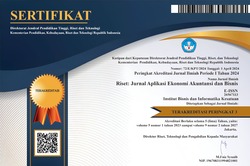THE EFFECT OF NATIONAL ECONOMIC RECOVERY ON THE FINANCIAL PERFORMANCE DURING THE COVID-19 PANDEMIC
DOI:
https://doi.org/10.37641/riset.v6i1.2073Keywords:
Economic Recovery, Market Power, Efficiency, Financial, Performance, COVID-19Abstract
The COVID-19 pandemic triggered a health crisis and ultimately had a broad impact on business. The slowdown in economic activity resulted in many businesses failing. In this crisis, the government's role is crucial in improving the economy. Based on the phenomenon, the study analyzes the impact of government roles and firm characteristics on financial performance during COVID-19. The sample is an Indonesian-listed company in the non-financial sector during 2020. Government intervention is proxied by National Economic Recovery (in Indonesia, known as Pemulihan Ekonomi Nasional-PEN) and firm characteristics by liquidity, efficiency, and market power. The study employed the difference-in-difference method to analyze the intervention and used ordinary least squares. National Economic Recovery is found inadequate to raise a firm's financial performance. Otherwise, efficiency and market power positively affect the firm financial performance. The study has some practical implications to execute. First, it is suggested that the government provide unemployment benefits equivalent to wage loss caused by the pandemic. Second, the firm must use its liquidity to adapt quickly to the environment since unused liquidity will be useless in the short term. Third, firms must also raise efficiency and market power to survive the pandemic.
Downloads
References
Alarussi, A. S., & Alhaderi, S. M. (2018). Factors Affecting Profitability in Malaysia. Journal of Economic Studies, 45(3), 442–458. https://doi.org/10.1108/JES-05-2017-0124
Bai, C., Quayson, M., & Sarkis, J. (2021). COVID-19 Pandemic Digitization Lessons for Sustainable Development of Micro-and Small- Enterprises. Sustainable Production and Consumption, 27, 1989–2001. https://doi.org/10.1016/j.spc.2021.04.035
Bank Indonesia. (2021). Annual Report 2020 : Synergizing to Build Optimism for Economic Recovery. https://www.bi.go.id/id/publikasi/laporan/Documents/Laporan-Akuntabilitas-Bank-Indonesia-2020.pdf
Barnichon, R., Debortoli, D., & Matthes, C. (2021). Can Government Spending Help to Escape Recessions? FRBSF Economic Letter, 1–5. https://www.frbsf.org/economic-research/wp-content/uploads/sites/4/el2021-02.pdf
BPS. (2020). Indonesian Statistics 2020. https://www.bps.go.id/publication/2020/04/29/e9011b3155d45d70823c141f/statistik-indonesia-2020.html
Bromiley, P., & Rau, D. (2016). Operations Management and The Resource Based View: Another View. Journal of Operations Management, 41(1), 95–106. https://doi.org/10.1016/j.jom.2015.11.003
Davidov, O., Jelsema, C. M., & Peddada, S. (2018). Testing for Inequality Constraints in Singular Models by Trimming or Winsorizing The Variance Matrix. Journal of The American Statistical Association, 113(522), 906–918. https://doi.org/10.1080/01621459.2017.1301258
Demmou, L., Franco, G., Calligaris, S., & Dlugosch, D. (2022). Liquidity Shortfalls During The COVID-19 Outbreak: Assessment and Policy Responses. Economie et Statistique / Economics and Statistics, 532–33, 47–61. https://doi.org/10.24187/ecostat.2022.532.2070
Egbunike, C. F., & Okerekeoti, C. U. (2018). Macroeconomic Factors, Firm Characteristics and Financial Performance. Asian Journal of Accounting Research, 3(2), 142–168. https://doi.org/10.1108/AJAR-09-2018-0029
Eichenbaum, M. S., Rebelo, S., & Trabandt, M. (2021). The Macroeconomics of Epidemics. The Review of Financial Studies, 34(11), 5149–5187. https://doi.org/10.1093/rfs/hhab040
Eichenbaum, M. S., Rebelo, S., & Trabandt, M. (2022). Epidemics in The New Keynesian Model. Journal of Economic Dynamics and Control, 140, 104334. https://doi.org/10.1016/j.jedc.2022.104334
Foo, L. P., Chin, M. Y., Tan, K. L., & Phuah, K. T. (2021). The Impact of COVID-19 on Tourism Industry in Malaysia. Current Issues in Tourism, 24(19), 2735–2739. https://doi.org/10.1080/13683500.2020.1777951
Fredriksson, A., & Oliveira, G. M. de. (2019). Impact Evaluation using Difference-in-Differences. RAUSP Management Journal, 54(4), 519–532. https://doi.org/10.1108/RAUSP-05-2019-0112
Guei, K. (2022). On The Role of Innovation and Market Structure on Trade Performance: Is Schumpeter Right? European Journal of Management and Business Economics, 32(2), 241–256. https://doi.org/10.1108/EJMBE-07-2021-0213
Hair, J. F., Black, W. C., Babin, B. J., & Anderson, R. E. (2014). Multivariate Data Analysis (7th ed.). New Jersey: Pearson Education Inc.
Hertati, L., Puspitawati, L., Gantino, R., & Ilyas, M. (2022). The Sales Volume and Operating Costs as Key Influencing Factors in Covid-19 Pandemic Era. Global Journal of Accounting and Economy Research, 3(1), 83–105.
Hitt, M. A., Arregle, J., & Holmes, R. M. (2021). Strategic Management Theory in a Post‐Pandemic and Non‐Ergodic World. Journal of Management Studies, 58(1), 259–264. https://doi.org/10.1111/joms.12646
Lechner, M., Rodriguez-Planas, N., & Fernández Kranz, D. (2016). Difference-in-Difference Estimation by FE and OLS When There is Panel Non-Response. Journal of Applied Statistics, 43(11), 2044–2052. https://doi.org/10.1080/02664763.2015.1126240
Lim, H., & Rokhim, R. (2020). Factors Affecting Profitability of Pharmaceutical Company: An Indonesian Evidence. Journal of Economic Studies, 48(5), 981–995. https://doi.org/10.1108/JES-01-2020-0021
Liu, H., Yi, X., & Yin, L. (2021). The Impact of Operating Flexibility on Firms’ Performance During The COVID-19 Outbreak: Evidence from China. Finance Research Letters, 38. https://doi.org/10.1016/j.frl.2020.101808
MoF. (2020). APBN KITA for August 2020. https://djpk.kemenkeu.go.id/wp-content/uploads/2020/10/apbn-kita-agustus-2020.pdf
Mogaji, E. (2020). Financial Vulnerability During a Pandemic: Insights for Coronavirus Disease (COVID-19). SSRN Electronic Journal, 2020(5), 57–63. https://doi.org/10.2139/ssrn.3564702
Rababah, A., Al‐Haddad, L., Sial, M. S., Chunmei, Z., & Cherian, J. (2020). Analyzing The Effects of COVID-19 Pandemic on The Financial Performance of Chinese Listed Companies. Journal of Public Affairs, 20(4). https://doi.org/10.1002/pa.2440
Ramadhan, M. I. (2020). These are The 4 Sectors Hardest Hitted by Covid-19. Media Indonesia. https://mediaindonesia.com/ekonomi/300402/ini-4-sektor-yang-paling-terpukul-covid-19
Shen, H., Fu, M., Pan, H., Yu, Z., & Chen, Y. (2020). The Impact of The COVID-19 Pandemic on Firm Performance. Emerging Markets Finance and Trade, 56(10), 2213–2230. https://doi.org/10.1080/1540496X.2020.1785863
Spitsin, V., Vukovic, D., Anokhin, S., & Spitsina, L. (2020). Company Performance and Optimal Capital Structure: Evidence of Transition Economy (Russia). Journal of Economic Studies, 48(2), 313–332. https://doi.org/10.1108/JES-09-2019-0444







